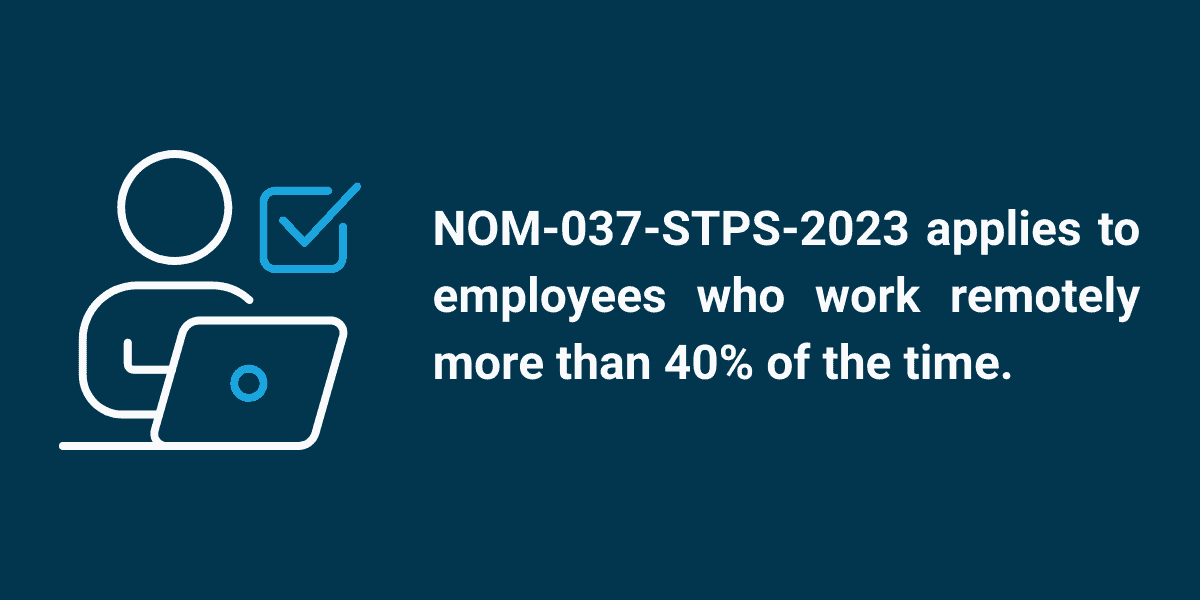Last updated on November 7th, 2024 at 09:58 am
Telework in Mexico, like everywhere else, became very popular during the COVID-19 pandemic. However, Mexico’s employment laws have regulated it since before that.
Firstly, let us remember that lawmakers created the Mexican Federal Labor Law (LFT) in 1970. Back then, there was no internet and no remote work. However, there have been reforms to this law. Since the last reform in 2021, lawmakers have dedicated an entire chapter in the Sixth Title, On Special Works, to Telework in Mexico. In 2023, the Labor Ministry published the official standard NOM-037-STPS-2023, Teleworking—Occupational Safety and Health Conditions, to further detail remote work regulations in Mexico. In this article, we take an in-depth look at these regulations.
So, let us get to it.

Regulations For Telework In Mexico
Let us begin with what we consider remote work in Mexico. Firstly, teleworking is a form of subordinate labor relationship where the work is performed in a place different from the employer’s establishment because it does not require the employee’s physical presence. Article 330-A of the LFT states this. So, you can immediately rule out bricklaying as teleworking.
Secondly, that same article states that information and communication technologies are necessary for teleworking in Mexico. So, that’s a convoluted legal way of saying what we already knew: only professions like coding and marketing, or something you do behind a computer, can work under the teleworking modality.
But here is the tricky part: the law considers a labor relationship as teleworking if the employee is outside the office more than 40% of the time. Therefore, for a Monday to Friday workweek, these are the rules:
- Employees who work from home for two days, i.e., 40% of the time, are regular workers.
- Employees who work from home for three days, i.e., 60% of the time, are teleworkers.
Employers and employees criticize this nuance because it encourages companies not to offer more than 40% work-from-home time, which means they don’t need to comply with the teleworking regulations.
Why? We will get to those in a moment, and you can judge for yourself if it’s worth it.
Compliance For Telework in Mexico
First, it is essential to understand that remote employees have the same mandatory employee benefits in Mexico as any other employee. As you will see in a moment, you could argue they have more. But let us start at the beginning.
Whenever you hire any employee, it is important to draft a Mexican labor agreement in compliance with the LFT. However, if the employee will be doing remote work more than 40% of the time, Article 330-B of the LFT states a few additional requirements for the contract. Let us take a look at the most important parts.
Article 330-B of the LFT, fraction IV. The equipment and work supplies, including those related to the obligations of safety and health that are delivered to the worker under the modality of teleworking.
As you can probably tell, the employer must buy the equipment and work supplies, including the computer and chair the employees will sit in. NOM-037-STPS-2023 even has some recommendations for selecting an ergonomic chair.
Article 330-B of the LFT, fraction V. The description and amount that the employer will pay to the worker under the modality of teleworking for payment of services at home related to teleworking;
You guessed it. If your employees telework in Mexico more than 40% of the time, your company must pay them an allowance for electricity, internet, and other services related to fulfilling their work. The law does not state a specific amount, but MXN 600 – 800 is a good amount based on our calculations. As the article states, including this in the labor agreement is important.
Article 330-B of the LFT, fraction VI. The mechanisms of contact and supervision between the parties, as well as the duration and distribution of schedules, provided that they do not exceed the legal maximums, and
The mechanisms must be compliant with Mexico’s workweek and overtime laws. It is also important to understand that employees can disconnect during their lunch break.
Reversibility Of Telework in Mexico
Another key point is that, according to Article 330-G of the LFT, companies that change from an on-site modality to telework in Mexico can reverse the change. This is a right that both parties (company and employees) have. If the employer considers that teleworkers are inefficient or that the workplace chosen by the employee is not suitable, he can request that the employee return to the office. If the company has reasons to believe the employee is suffering family violence, it must bring the employee back.
On the other hand, if an employee feels uncomfortable working from home, they can request to return to the office. Legally, no justification is needed; if the employee or the company wishes to reverse the modality, they can request it.
According to NOM-037, the company must clearly state the mechanisms for reversibility in the Telework Policy and request it 20 days in advance.
Employer’s Obligations For Telework In Mexico
Article 330-E of the LFT and Section 5 of the NOM-037-STPS-2023 state the employer’s obligations. Let’s examine the most important ones.
Keeping A List
Section 5.1 of NOM-037 specifies that employers must keep an updated list of employees working under the home office modality with the following information.
- Name of the workers under the Telework modality;
- Genre;
- Marital status
- Activities to be developed;
- Name and job profile;
- Time (in percentage) of the work relationship used to perform telework;
- Contact telephone number;
- Address of the workers under the modality of telework;
- Workplaces proposed by the workers under the Telework modality and agreed with the employer;
- Company name and address of the work center.
- A list of the computer and ergonomic equipment provided to the employee.
Designated Workplaces For Telework In Mexico
Now, let us focus on number 8, the address where the workers will be working. Employees may propose their home as their work location, but they may also propose a different place, such as a cafeteria or their grandmother’s house.
It is important to note that employees doing telework in Mexico can not work from wherever they want. The remote workplaces are fixed. If the company and the employee agree, they can state more than one workplace, but all these places must be thoroughly checked and documented.
Section 5.1.1 of the Nom-037 states the conditions for a place to be acceptable to work from:
- Have connectivity for the use and management of Information and Communication Technologies
- To have proper safety and health conditions and good electrical installations, lighting, ventilation, and ergonomic conditions.
How can a company make sure these conditions are met?
NOM-037-STPS-2023 Section 5.5 gives us the answer. Companies must document the workplace with photos and videos. To obtain this evidence, the employer has the following options.
- To visit the workplace (with the previous authorization of the employee).
- If visiting is not possible, he can request the evidence from the employee.
Provide The Necessary Tools
Employers must provide the necessary tools to fulfill telework requirements in Mexico. This is first seen in Article 330-E of the LFT and is explained in more detail in Section 5.7 of the NOM-037-STPS-2023.
Article 330-E of the LFT
- I. Provide, install and take care of the maintenance of the necessary equipment for teleworking such as computer equipment, ergonomic chairs, printers, among others;
- III. Assume the costs derived from the work through the modality of telework, including, in its case, the payment of telecommunication services and the proportional part of electricity;
Section 5.7 of the NOM-037-STPS-2023
To provide to the workers under the modality of Teleworking to develop their activities outside the work center, the following:
- Ergonomic chair or other type of chair appropriate to the activities to be developed;
- The necessary inputs for its adequate performance, such as for sending the information digitally, or printing it; and
- If applicable, the attachments that guarantee ergonomic or postural conditions of the worker during the working day.
This is pretty clear. You cannot tell your employee to use his computer; you must provide him with the necessary means to work from home, including an ergonomic chair compliant with Appendix 4 of the Nom-037-STPS-2023.
Telework Policy
According to Section 5.2 of the NOM-037, Employers must draft and distribute a telework policy among their employees. This telework policy must:
- Promote a culture of occupational risk prevention.
- Establish communication mechanisms to avoid social isolation.
- Facilitate the means of communication so that the workers know the procedures referred to in Article 330-C of the LFT.
- Indicate the contact rules, guaranteeing the workers’ right to privacy.
- Establish the duration of the agreed working hours following Mexico’s work week and overtime laws. Employees have the right to disconnection. Article 330-E of the LFT, fraction VI, states this.
- The rights of teleworkers may not be less than those of regular employees.
- Promote the gender perspective and consider the provisions in Article 132, section XXXI of the LFT.
- Determine the policies for maternity and breastfeeding.
- Establish how workers can inform changes of address for their workplace.
- Define the responsibilities and obligations in compliance with Article 330-B of the LFT.
- Establish the mechanisms to apply for the reversibility of telework according to the provisions of Article 330-G of the LFT.
If you need some inspiration, you can find examples of telework policies in Appendix 1 of the NOM-037-STPS-2023.
Domestic Violence
As we already stated, one of the employer’s obligations is to ensure the remote workplace is safe. This includes making sure it is free of domestic violence. According to Section 5.13 of NOM-037-STPS-2023, it is the employer’s responsibility to have care mechanisms for cases of domestic violence that consider, among other things, a return to the face-to-face modality on a temporary or permanent basis.
Medical Examinations
Another obligation is to provide remote employees with medical examinations following the provisions of NOM-030-STPS-2009 and to follow up on notices of accidents suffered in the remote workplace while exercising their telework activities. To do this, companies must always observe the protocols established by social security institutions.
Training Remote Employees
Companies must train their employees. We first see this in the LFT.
Article 330-E of the LFT, fraction VI.Establish the mechanisms of training and advice necessary to ensure the adaptation, learning and proper use of information technologies of workers in the modality of teleworking, with special emphasis on those who change from face-to-face modality to teleworking.
Lawmakers developed this in Section 8 of the NOM-037-STPS-2023, which states that the company must conduct training remotely or face-to-face.
Other Employer’s Obligation
Article 330-E of the LFT, fraction IV. Keep record of the inputs delivered to workers under the modality of teleworking, in compliance with the provisions on safety and health at work established by the Ministry of Labor and Social Welfare;
This may sound like a mere bureaucratic procedure. However, Article 330-K of the LFT, which discusses the duties of the labor inspectors, states that one of their duties is to ensure a registry of the inputs. This means there are fines if you do not comply.
Article 330-E of the LFT, fraction V. Implement mechanisms that preserve the security of information and data used by workers in the teleworking modality;
Lastly, it is the employer’s responsibility to ensure cybersecurity. In this regard, the Ministry of Communications and Transport created a Cybersecurity Guide for using networks to support telework in Mexico. This guide has broad recommendations for protecting against the most common cyber attacks.
Employee’s Obligations
Now, let us examine what the law obliges the remote workers to do. Article 330-F of the LFT and Section 6 of NOM-037 state this.
Article 330-F of the LFT, fraction I. To take the greatest care in the storage and conservation of equipment, materials and tools received from the employer;
As you can see, employees must reciprocate the company’s obligations. Remember how the company is obliged to provide them with the necessary equipment? Employees must take care of this equipment, and not taking care of it may even be a cause for justified termination.
Article 330-F of the LFT, fraction II. To inform with opportunity on the costs agreed for the use of the services of telecommunications and of the consumption of electricity, derived from the telework;
This is related to the company’s obligation to pay for these services. The company must do it in coordination with the employee. It is a good idea for companies to work with employees to find a good internet provider; this way, the company ensures good connectivity.
Other Employee’s Obligations
Article 330-F of the LFT, fraction III. Obey and conduct themselves in accordance with the provisions on occupational health and safety established by the employer;
Article 330-F of the LFT, fraction IV. Attend and use the mechanisms and operating systems for the supervision of its activities; and
Article 330-F of the LFT, fraction V. To comply with the policies and mechanisms for the protection of data used in the performance of its activities, as well as the restrictions on its use and storage.
Conclusion
The LFT and NOM-037-STPS-2023 regulate Telework in Mexico. Accordingly, remote workers cannot work from wherever they want. They must request it the workplace to the employer, and the employer must inspect it to ensure its safety.
Moreover, employers must cover work-related expenses for teleworkers, such as internet, electricity, and proper equipment.



Add your first comment to this post